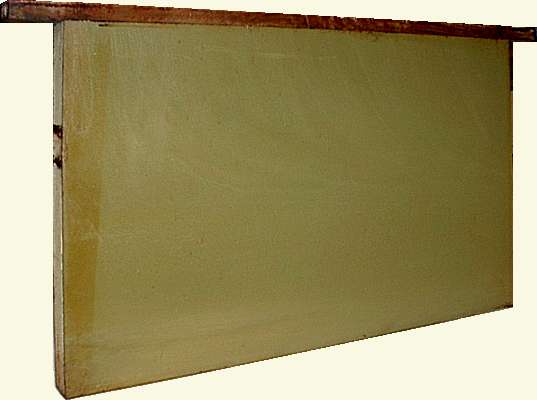The division board is called a follower board in the US and as it is the full internal dimensions of the hive, with no bee spaces around it, it can be used to 'partition off' part of a bee hive, to render it less useful to the bees or it can be used to fill minor gaps at the ends of groups of frames. In some circumstances it can be used to separate independent nucs.
I have made these using 6 mm, 8 mm, 9 mm, 12 mm and 16 mm exterior grade plywood. There are always a few spare ones of various thicknesses in my van or in an apiary inside an empty hive, so that I can accommodate changes in hive make up.

I treat the absorbent edges with Petroleum Jelly and the flat faces are painted with Raw Linseed Oil.
For National use the board should be 225 mm tall, the width should be arranged so that the division board can be slid into a box without jamming, as there is a little variability in the inside dimensions of hive boxes, you will need to make your boards to suit the boxes concerned. I personally allow 1 mm each side as a clearance. In the past the division boards were made slightly small and the edges were then padded with a fold of oilcloth which gave an almost gas tight seal, however I do not believe there is any benefit in this degree of tightness.
For complete closure if used above a floor, you will need to fit a strip of wood to the floor or tack a strip on to the bottom edge of the board to stop bees crawling under the barrier.
The 9 mm strap across the top serves to strengthen the lug and increases the area of the top surface. This allows for some misalignment, of strips fitted under queen excluders, in the case that two nucs are being separated within one box. It also stiffens any boards made from the thinner ply woods. For top bee space this strip can be 28 mm vertical height, for normal National this can bar be 18 mm to 22 mm broad. Division boards made of thin plywood may benefit from a stiffening strap on both sides of the plywood panel.
In the case where there are nucs with queens, the space under the frame lugs needs to be blocked to avoid one queen killing the other, or worker bees migrating to the other colony, because they 'prefer' that queen.
If the boards are left in place for a long time they will attract accretions of propolis around the edges, this is of no consequence if adequate amounts of petroleum jelly have been used.
Division boards and dummy frames are often confused with each other in beekeeping conversations.

Some years ago there was a type of division board available from the Steele and Brodie company, that was made from skinned polyurethane foam, I used a few of these myself, sometimes in groups of three or four in order to fill up empty spaces within hives. My usage of such
was rather like the approach used by Ben Harden in his
This type of division board was never used to separate different colonies within the same box and so there is no fancy woodwork on the underside of the frame lugs. Also missing from this type of board is the spacing elements that are made from the Hoffman frame adaptors. These division boards are light in weight, but very stiff, with flat parallel sides... The material is 28 mm thick.
Dave Cushman.
Page created pre-2011
Page updated 06/12/2022